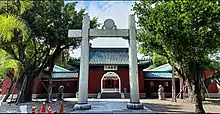| Koxinga Shrine | |
|---|---|
 | |
| Religion | |
| Affiliation | Shinto |
| Deity | Koxinga |
Koxinga Shrine (延平郡王祠) is a temple in Taiwan which was briefly a Shinto shrine in Taiwan during Japanese rule before being reconverted. It was built in Tainan long before Japanese rule in honor of Koxinga, a leader born in Japan who drove out the Dutch from Taiwan.[1] The Japanese are perceived as having attempted to pervert his long legacy as a folk hero for use in legitimizing their rule of Taiwan.[2][3] with the idea that Taiwan was always separate from China.[4] There is an annual festival on his birrthday July 14 at the shrine today.[2]
He was also known as a rebel against the Manchu invasion of China with his Japanese mother committing suicide rather than be captured by the Qing.[5]
The Qing dynasty moved his grave to Fujian in 1699 and banned his worship. But the people of Taiwan continued to worship him secretly under the name "Prince Zhu".[5]
It was renamed Koxinga Shrine (zh, 延平郡王祠, 開山神社) by the Imperial government[6]: 107 during the Japanese occupation of Taiwan.
It was originally built in 1662 by Zheng Jing as an Ancestral shrine for his father Koxinga in a Chinese style.[7]
The death of Prince Kitashirakawa Yoshihisa was presented as parallel to the much older story of the life of Koxinga, a Japanese man who became an official under the Ming dynasty, and was forced to flee to Taiwan after the Qing took over, drove the Dutch from Taiwan and died of malaria.[6]: 107
Koxinga Shrine was built by the followers of Koxinga and the Japanese converted it into a Shinto Shrine after their invasion. Governor of Taiwan Isogai Seizō requested it be Taiwan's top Shinto Shrine and called Kaitai Jinja (lit. ‘Opening-Taiwan Shrine’) but it ended up only being ranked quite low as a prefectural shrine called Kaizan Shrine.[6]: 108
The shrine's location and recognition were influenced by multiple factors. Taiwanese mausoleums bore a resemblance to Shinto shrines, prompting Taiwanese Shintoists to view them similarly. Additionally, the site's popularity among the Taiwanese and the legend of Koxinga could be harnessed to reinforce the legitimacy of Japanese rule in Taiwan.[6]: 108
Kaizan Jinja was unique, as it was a pre-existing shrine-mausoleum that became recognized as a Shinto shrine. Despite significant Japanization efforts, the shrine maintained many Taiwanese elements. For instance, during major festivals, local-style theatre and martial arts were performed. Footage from the 1930s showcases a blend of Japanese and Taiwanese customs during the shrine's celebrations.[6]: 108
In 1942 the governor of Chūreki District in Shinchiku (Hsinchu) Prefecture, Miyazaki Naokatsu argued that the mausoleums of Taiwan were Shinto, and when Taiwan joined Japan the Taiwanese kami became Japanese kami..[6]: 108
Tainan Shrine was built on the site of the death of the prince, a few blocks away from Koxinga Shrine.[6]: 110 It was unique in being granted permission to worship only the prince and no other deities, as almost all other shrines would worship the three pioneer kami too..[6]: 112
In the 1960s the shrine was converted back to a Confucian one, and today it is still popular among the people of Taiwan.[5]
It has been considered a source of legitimization likewise of the Nationalist government and later Republic of China government against the ascendant People's Republic of China.[8] Visits by Chiang Kai-shek made that clear.[8]
It shares this status with other converted Shinto shrines such as the National Revolutionary Martyrs' Shrine and many other Martyrs' shrines in Taiwan.[9]
See also
References
- ↑ Koxinga Shrine(延平郡王祠)-Cultural Affairs Bureau, Tainan City Government (2017-11-01). "Koxinga Shrine(延平郡王祠)-Cultural Affairs Bureau, Tainan City Government". Koxinga Shrine(延平郡王祠)-Cultural Affairs Bureau, Tainan City Government. Retrieved 2023-10-27.
- 1 2 Shei, Chris (2021-03-01). Taiwan: Manipulation of Ideology and Struggle for Identity. Routledge. ISBN 978-1-351-04783-8.
- ↑ Damm, Jens; Neddermann, Hauke (2020). Intercultural Dialogue across Borders: China between Tradition and Modernity. LIT Verlag Münster. ISBN 978-3-643-91254-1.
- ↑ Tzeng, Shih-jung (2009-05-16). From Honto Jin to Bensheng Ren: The Origin and Development of Taiwanese National Consciousness. University Press of America. ISBN 978-0-7618-4472-3.
- 1 2 3 Crook, Steven (2019-06-05). Taiwan. Bradt Travel Guides. ISBN 978-1-78477-622-0.
- 1 2 3 4 5 6 7 8 Shimizu, Karli; Rambelli, Fabio (2022-10-06). Overseas Shinto Shrines: Religion, Secularity and the Japanese Empire. London New York (N.Y.) Oxford: Bloomsbury Academic. ISBN 978-1-350-23498-7.
- ↑ D, John (2016-10-02). "Koxinga Shrine in Taiwan". Green Shinto. Retrieved 2023-10-27.
- 1 2 Harrison, M. (2016-03-15). Legitimacy, Meaning and Knowledge in the Making of Taiwanese Identity. Springer. ISBN 978-0-230-60169-7.
- ↑ Pan, Lu (2021-01-02). Image, Imagination and Imaginarium: Remapping World War II Monuments in Greater China. Springer Nature. ISBN 978-981-15-9674-2.